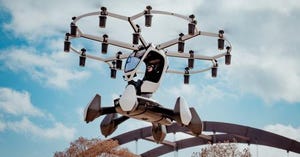Big data and IoT technologies could be used to thwart terrorist attacks before they happen, but making this sci-fi possibility into a reality is no easy feat.
December 1, 2016

Before Ahmad Khan Rahami planted bombs in New York and New Jersey, he bought bomb-making materials on eBay, linked to jihad-related videos from his public social-media account and was looked into by law enforcement agents, according to the Federal Bureau of Investigation.
If only the authorities had connected the dots.
That challenge — mining billions of bits of information and crunching the data to find crucial clues — is behind a push by U.S. intelligence and law enforcement agencies to harness “big data” to predict crimes, terrorist acts and social upheaval before they happen. The market for such “predictive analytics” technology is estimated to reach $9.2 billion by 2020, up from $3 billion in 2015, according to research firm MarketsandMarkets.
It’s the stuff of a science-fiction movie like “Minority Report,” in which Tom Cruise played a Washington cop who used technology to arrest people before they carried out crimes. It’s also a red flag for privacy advocates already fighting U.S. spy programs exposed by Edward Snowden and the FBI’s demands that Apple Inc. help it hack into encrypted mobile phones.
The idea is to make sense of the vast and disparate streams of data from sources including social media, GPS devices, video feeds from street cameras and license-plate readers, travel and credit-card records and the news media, as well as government and propriety systems.
‘Fundamental Fuel’
“Data is going to be the fundamental fuel for national security in this century,” William Roper, director of the Defense Department’s strategic capabilities office, said at a conference in Washington last month.
For the first time, the White House released a strategic plan on Wednesday to advance research and development of artificial intelligence technology, including to predict incidents that may be dangerous to public safety.
Weeks before Rahami allegedly carried out the attacks in September, he bought circuit boards, electric igniters and ball bearings — all of which are known bomb-making materials, according to charging documents from the FBI.
In previous years, he was flagged by U.S. Customs and Border Protection and the FBI after he made trips to Pakistan and after his father told police he was a terrorist, before recanting the remark.
Previous Story: FBI Check Found No Terrorist Ties in ’14
Law enforcement agents could have been tipped off that Rahami was moving toward an attack had all of those data points been culled together in one place, said Mark Testoni, chief executive officer and president of SAP National Security Services Inc., a U.S.-based subsidiary of German software company SAP SE.
“This is a big data world now,” said Testoni. He said his company has developed a computer platform for doing predictive analytics that is being used in a limited way by a Defense Department agency and by a national security agency. He declined to name the government customers or specify what they are doing.
The technology to predict events is only in its infancy, Testoni said. National security and law enforcement agencies also have different rules when it comes to obtaining and using data, meaning there are walls between what can be accessed and shared, he said. U.S. law enforcement agencies, for example, need a court warrant to access most data.
Big Brother
Privacy advocates express concern about the “Big Brother” implications of such massive data-gathering, calling for more information and public debate about how predictive technology will be used.
“There’s often very little transparency into what’s being brought into the systems or how it’s being crunched and used,” said Rachel Levinson-Waldman, senior counsel to the National Security Program at the Brennan Center for Justice at New York University School of Law. “That also makes it very hard to go back and challenge information that might be incorrect.”
Computer algorithms also fail to understand the context of data, such as whether someone commenting on social media is joking or serious, Levinson-Waldman said.
Testoni’s company and others such as Intel Corp. and PredPol Inc. are among a handful of firms pioneering the use of predictive analytics and artificial intelligence for clients from local police departments to U.S. national security agencies.
More than 60 local police departments in the U.S. have started making use of a service sold by PredPol, which calls itself “The Predictive Policing Company,” to forecast where crimes might occur based on past patterns, said co-founder Jeff Brantingham.
What, Where, When
Its system, developed in collaboration with the Los Angeles Police Department, uses only three types of data: what type of crime occurred, when and where, Brantingham said.
Then, a software algorithm generates the probability of crime occurring in different locations, presented as 500-foot-by-500-foot squares on a computer display or a printed map. With that insight, police departments then can make decisions about how best to apply their resources, such as sending cops to a high-risk area, or which security cameras to monitor, Brantingham said.
PrePol’s system doesn’t make predictions about who will commit a crime, so it stops short of a system that might identify a terrorist in the making.
“Interdicting places is, by and large, an approach that is more in line with protecting civil liberties than interdicting people,” Brantingham said.
Even with such limits, privacy and civil liberties groups oppose the use of predicting policing technology as a threat to the Constitution’s promises of equal protection and due process.
‘Fortune-Teller Policing’
“This is fortune-teller policing that uses deeply flawed and biased data and relies on vendors that shroud their products in secrecy,” Wade Henderson, president and chief executive officer of the Leadership Conference on Civil and Human Rights. “Instead of using predictive technology to correct dysfunctional law enforcement, departments are using these tools to supercharge discrimination and exacerbate the worst problems in our criminal justice system.”
eBay, Amazon
Vast databases that companies have created for online commerce and communications could help law enforcement and national security agencies build predictive systems if they are allowed to tap into them. Technology companies have terms of service that set out how much personal information can be kept and sold to outside companies such as advertisers, and most resist handing over such data to the government unless a court orders them to do so.
Predictive analytics are already being used by companies like eBay Inc., Amazon.com Inc., and Netflix Inc. to crunch their users’ Internet activity to forecast what they might be interested in. Companies like Facebook Inc. and Twitter Inc. have access to over a billion social-media accounts. The storehouse of data on Americans will only grow with digital feeds from Internet-connected appliances and wearable devices.
Social media, in particular, is a valuable tool in tracking potential terrorist attacks, said Eric Feinberg, founding member of the Global Intellectual Property Enforcement Center, which is a private company. His firm has patented technology that can scan for hashtags across different social media platforms and in different languages for communications that indicate terrorist planning.
“Our software is about pattern analysis,” Feinberg said. “We focus on the communications stream.”
‘Open Source Indicators’
The U.S. government is working on initial efforts to gain insight into global social and political trends.
A program under the intelligence community’s research arm called Mercury seeks to develop methods for continuous and automated analysis of intercepted electronic communications “in order to anticipate and/or detect political crises, disease outbreaks, terrorist activity and military actions,” said Charles Carithers, spokesman for the Intelligence Advanced Research Projects Activity.
The agency also previously funded the Open Source Indicators program, which “developed methods for continuous, automated analysis of publicly available data in order to anticipate and/or detect significant societal events,” such as mass violence and riots, mass migrations, disease outbreaks and economic instability, Carithers said.
CIA Forecasts
The CIA draws a distinction between using technology to anticipate events, versus predict them. The agency is using sophisticated algorithms and advanced analytics, along with publicly available data, to forecast events. The initial coverage focuses on the Middle East and Latin America.
“We have, in some instances, been able to improve our forecast to the point of being able to anticipate the development of social unrest and societal instability to within three to five days out,” said Andrew Hallman, the agency’s deputy director for digital innovation.
In its annual report in June, the Defense Science Board said, “Imagine if national leaders had sufficient time to act in emerging regional hot spots to safeguard U.S. interests using interpretation of massive data including social media and rapidly generate strategic options.”
“Such a capability may soon be achievable,” the board said. “Massive data sets are increasingly abundant and could contain predictive clues — especially social media and open-source intelligence.”
Poindexter’s Legacy
If U.S. intelligence agencies develop an advanced system to predict terrorist acts they might call it “Total Information Awareness.” Except that name has already been used, with unhappy results.
Retired Admiral John Poindexter created the “Total Information Awareness” program for the Pentagon’s Defense Advanced Research Projects Agency in 2002 to find and monitor terrorists and other national security threats using data and technology.
The program became so controversial, especially over concerns that privacy rights would be violated, that Congress canceled funding for Poindexter’s office in 2003.
Having been there and done that, Poindexter now says predicting terrorism is possible but would require a lot of data, such as banking information, analysis of social media, travel records and classified material.
The system also has to include strong privacy protections that the public can review, said Poindexter, who said he was working on such a “privacy protection application” when his program was canceled.
“You have to develop public trust in the way this is going to work,” said Poindexter, who continued developing the technology after leaving government through Saffron Technology Inc., a cognitive computing company that Intel bought in 2015 for an undisclosed price. Intel declined to comment.
“The government’s priorities should be to solve the privacy issue and start ingesting massive amounts of data into memory bases,” Poindexter said. “You have to get the public on board with the idea that we can collect and search information on terrorist planning that doesn’t have an adverse impact on innocent people.”
About the Author(s)
You May Also Like
.jpeg?width=700&auto=webp&quality=80&disable=upscale)
.png?width=700&auto=webp&quality=80&disable=upscale)



.png?width=300&auto=webp&quality=80&disable=upscale)
